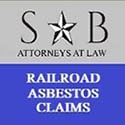
Asbestos exposure is a serious health risk that has affected many railroad workers over the years. Due to its heat-resistant properties, asbestos was commonly used in various materials and equipment within the railroad industry. The introduction of asbestos into the railroad sector was primarily driven by its exceptional insulating abilities and resistance to fire, which were crucial for maintaining safety and efficiency in an industry heavily reliant on high-temperature operations. However, the very qualities that made asbestos so valuable also rendered it hazardous, as its fibers, when disturbed, could easily become airborne and pose significant health risks.
In this article, we’ll explore the risks associated with asbestos exposure in the railroad industry, the symptoms of asbestos-related diseases, and the legal support available for affected workers. By understanding these aspects, both current and former railroad workers can better assess their health risks and take informed steps towards safeguarding their well-being. Moreover, this knowledge empowers them to pursue rightful compensation and justice in the unfortunate event of asbestos-induced health issues.
Understanding Asbestos Exposure in the Railroad Industry
Railroad workers have historically been at risk of asbestos exposure due to the extensive use of this hazardous material in trains and related facilities. Asbestos was used in brake pads, insulation for pipes, boilers, and even in the construction of railroad cars. The pervasive use of asbestos extended beyond just trains, as it was also incorporated into various components of railway infrastructure, including signal boxes and station facilities. This widespread integration increased the likelihood of exposure for workers across different roles and responsibilities within the railroad industry.
Unfortunately, the fibers can become airborne, and when inhaled, they pose serious health risks. Once inhaled, these microscopic fibers can lodge themselves in the lung tissue, leading to inflammation and scarring over time. This latent period between exposure and the onset of symptoms often complicates the diagnosis and treatment, as the effects of asbestos exposure may not become apparent for decades. As a result, many workers may not even be aware of their exposure until symptoms manifest, making awareness and preventive measures all the more critical.
Why Was Asbestos Used in Railroads?
Asbestos was prized for its durability and resistance to heat and fire. These properties made it an ideal material for use in the railroad industry, where high temperatures and the need for fireproofing were common concerns. The steam engines and later diesel locomotives generated significant heat, necessitating effective insulation to protect both the machinery and the workers operating them. Asbestos, with its cost-effectiveness and versatility, met these demands efficiently, leading to its widespread adoption.
However, the health risks associated with asbestos were not well understood for many years, leading to widespread use despite the dangers. It wasn’t until the latter half of the 20th century that the severe health implications of asbestos exposure became widely recognized. By then, countless workers had already been exposed. The delay in understanding the risks highlights a critical gap in occupational health and safety practices of the time, emphasizing the need for ongoing vigilance and education in industries where hazardous materials are used.
How Railroad Workers Were Exposed
Railroad workers could be exposed to asbestos in several ways. Repair and maintenance work often disturbed asbestos-containing materials, releasing fibers into the air. This was particularly true for workers involved in routine maintenance and overhauls of trains, where they frequently came into contact with asbestos-insulated pipes, gaskets, and brake components. The mere act of sanding, cutting, or drilling into asbestos-laden materials could release dangerous fibers into the surrounding environment.
Construction of trains and facilities also posed significant exposure risks. Workers involved in building or renovating railroad cars and stations were often exposed to asbestos during construction processes. The dust generated during these activities could easily become airborne, increasing the risk of inhalation. Moreover, even routine operations in environments containing asbestos materials could lead to exposure over time. Workers who spent prolonged periods in such environments faced cumulative exposure risks, which could significantly increase their likelihood of developing asbestos-related diseases.
Symptoms of Asbestos Exposure
Asbestos exposure can lead to several serious health issues, primarily affecting the respiratory system. Recognizing the symptoms early can lead to a timely diagnosis and better management of the condition. Early detection is crucial, as it allows for more effective treatment options and can significantly improve a patient’s quality of life. Furthermore, understanding the potential symptoms can empower individuals to seek medical advice promptly, potentially mitigating long-term health impacts.
Common Symptoms of Asbestos Exposure
Symptoms of asbestos exposure often do not appear until many years after initial exposure. Some common symptoms include persistent cough, which can be an early indicator of respiratory distress caused by asbestos fibers. This cough may be accompanied by shortness of breath, as asbestos fibers can cause lung inflammation and scarring, impeding normal lung function.
Chest pain or tightness can be a symptom of asbestos lung disease, indicating potential damage to lung tissue or the pleura, the lining of the lungs. Fatigue and unexplained weight loss are also concerning symptoms, often signaling the body’s struggle with an underlying health issue such as asbestosis or mesothelioma. These symptoms, while common to many illnesses, hold particular significance for individuals with a history of asbestos exposure. If you experience any of these symptoms and have a history of asbestos exposure, it’s important to seek medical attention promptly.
Asbestos-Related Diseases
Exposure to asbestos can lead to several serious diseases, including asbestosis, a chronic lung disease caused by inhaling asbestos fibers, which leads to lung scarring and breathing difficulties. Asbestosis can significantly impair lung function, causing a decline in physical abilities and overall health. Additionally, it increases the risk of developing more severe conditions over time, such as mesothelioma and lung cancer.
Mesothelioma is a rare form of cancer that affects the lining of the lungs, chest, or abdomen. This aggressive cancer is almost exclusively linked to asbestos exposure and often has a poor prognosis due to late-stage diagnosis. Lung cancer, another potential outcome of asbestos exposure, can be exacerbated by smoking, with asbestos exposure significantly increasing the risk. The combination of smoking and asbestos exposure creates a synergistic effect, drastically heightening the likelihood of developing lung cancer.
Legal Support for Affected Workers
Workers affected by asbestos exposure in the railroad industry have legal rights and options for seeking compensation. Law firms like Sammons & Berry specialize in helping victims of asbestos exposure get the justice and compensation they deserve. Understanding your legal options is crucial, as it allows affected individuals to secure financial compensation for medical expenses, lost wages, and other damages incurred due to asbestos-related illnesses.
How Sammons & Berry Can Help
Sammons & Berry is a law firm with extensive experience in handling asbestos-related cases. They provide guidance and representation for workers who have developed health issues due to asbestos exposure. Their services include comprehensive case evaluation to assess the details of your situation and determine the best legal approach. This initial step is vital for building a strong case and ensuring that all relevant factors are considered.
The firm assists with compensation claims, helping you file claims for medical expenses, lost wages, and other damages. Their legal representation ensures that your rights are protected throughout the legal process, offering strong advocacy in court if necessary. Sammons & Berry’s expertise in asbestos litigation provides clients with confidence and peace of mind, knowing they have knowledgeable professionals fighting on their behalf.
Steps to Take If You’ve Been Exposed
If you believe you’ve been exposed to asbestos, consider taking these steps. First, seek a medical consultation to discuss your symptoms and any potential exposure to asbestos. Early medical intervention can lead to more favorable health outcomes and provide essential documentation for any future legal claims.
Next, document your exposure by keeping records of your work history and any instances of exposure to asbestos. This documentation can be crucial for establishing a timeline of exposure and linking it to your health issues. Lastly, consult a lawyer, reaching out to law firms like Sammons & Berry to discuss your legal options. Legal counsel can provide valuable insights into the compensation process and help you navigate the complexities of asbestos litigation.
Choose Sammons & Berry
Asbestos exposure remains a significant health risk for railroad workers, with potentially severe consequences. Recognizing the symptoms and understanding the diseases linked to asbestos can help in seeking timely medical and legal assistance. With the right support, affected workers can pursue compensation and justice for their suffering, ensuring that they receive the care and financial restitution they deserve.
If you or a loved one has been affected by asbestos exposure, it’s crucial to act quickly. Early intervention can make a significant difference in managing health conditions and securing legal compensation. By taking proactive steps, affected individuals can better protect their health and safeguard their financial future, providing a measure of relief amid the challenges posed by asbestos-related illnesses.
See if you qualify for compensation
Sammons & Berry, P.C.
800-519-1440
View our Google Listing
View our Facebook


